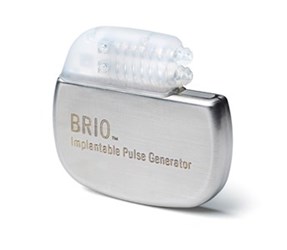FDA Clears St. Jude's Brain Implant For Parkinson's Disease
By Jof Enriquez,
Follow me on Twitter @jofenriq

The U.S. Food and Drug Administration (FDA) recently approved a deep brain stimulation system (DBS) made by St. Jude Medical to alleviate symptoms of Parkinson's disease and essential tremor, the first such device for those indications approved by the agency in almost two decades.
The Brio Neurostimulation System "can help some patients when medication alone may not provide adequate relief from symptoms such as walking difficulties, balance problems, and tremors," the FDA stated in a news release. The agency said 1 million Americans suffer from Parkinson's disease, a progressive, degenerative condition of the nervous system that affects movement. Essential tremor, a condition causing uncontrollable shaking of the upper extremities, affects more than 10 million Americans.
“There are no cures for Parkinson’s disease or essential tremor, but finding better ways to manage symptoms is essential for patients,” said William Maisel, M.D., M.P.H., acting director of the Office of Device Evaluation at the FDA’s Center for Devices and Radiological Health (CDRH), in the release. “This new device adds to the array of treatment options to help people living with Parkinson’s and essential tremor enjoy better, more productive lives.”
The Brio system consists of a small (1.9” x 2.1” x 0.4”) battery-powered, rechargeable, pacemaker-like pulse generator that is implanted in the chest and attached to wire leads that connect to electrodes placed in regions of the brain that control body movement. The generator transmits electrical signals to the brain to help reduce symptoms, such as tremors or shaking.
The FDA cited two studies that demonstrated the safety and effectiveness of the Brio system for patients whose symptoms were not adequately controlled by medication alone. One study included 136 patients with Parkinson’s disease, while another study included 127 patients with essential tremor. Both groups showed statistically significant improvement on their primary effectiveness endpoint when the device was turned on compared to when it was turned off, the FDA said.
The agency noted that the Brio system is only the second device cleared for the treatment of Parkinson’s and essential tremor. The first device approved for those two conditions, Medtronic’s Activa Deep Brain Stimulation Therapy System, was approved in 1997.
Medtronic has since enhanced its pioneering device, making it MRI-safe for full body imaging, improving its safety and precision, and making it the first DBS system with the ability to sense and record brain activity while simultaneously providing targeted DBS therapy. The company claims more than 115,000 patients have benefited from its DBS stimulators.
Traditional DBS has helped thousands of patients who have not responded well to drugs in reducing their symptoms. However, the invasive nature of DBS has researchers devising ways to refine the system without having to use implants.
One group of scientists from MIT has found a noninvasive way to treat Parkinson's using magnetic nanoparticles. Their technique involves the injection of iron oxide particles that are subjected to an external alternating magnetic field, which heats up the particles and stimulates deep brain tissue. Unlike conventional transcranial magnetic stimulation, which can only reach brain tissue near the surface, this newer technique can penetrate deeper tissue, making therapy more effective, the researchers claim.
Nanotechnology also is being used by NASA and the Mayo Clinic to create a more specific and sensitive DBS system consisting of nine carbon nanofiber pads, each coated with a biocompatible polymer. The system is said to be capable of recording up to 100,000 neurochemical readings per second for over four months.
Another group of researchers from Johns Hopkins University is refining a method called transcranial direct current stimulation that does away with brain surgeries and injections altogether. They have created a prototype headband with electrodes that deliver mild electrical current to the motor areas of the brain. The biomedical team of student researchers plans to test the wearable device on real patients in a future clinical trial.
